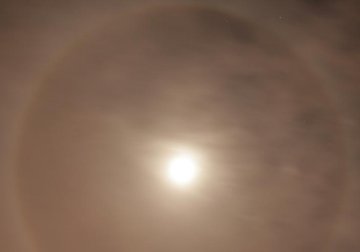 Where's Saturn? Is that a UFO--or the ISS? What's the name of that star? Get the answers from mySKY--a fun new astronomy helper from Meade. Where's Saturn? Is that a UFO--or the ISS? What's the name of that star? Get the answers from mySKY--a fun new astronomy helper from Meade. MARS DOUBLES IN BRIGHTNESS: During the past month, Mars has doubled in brightness and now it is putting on a nice show for backyard stargazers. A good night to look is Nov. 26th when Mars has an eye-catching close encounter with the Moon: full story. COMET 17P/HOLMES: Exploding Comet Holmes is fading as it expands, and it is no longer easy to see with the naked eye, but it remains a good target for off-the-shelf digital cameras. A ~20 second exposure yields a print like this: 
"After midnight the sky cleared up and the comet was an easy target in my suburban sky even without a telescope," says photographer Peter von Bagh of Porvoo, Finland. Comet Holmes is now about as wide as a full Moon with a vast atmosphere that overlaps the bright star Mirfak. It's a beautiful ensemble for cameras and backyard telescopes alike. Take a look tonight after sunset: sky map. Comet 17P/Holmes Photo Gallery
[Interactive World Map of Comet Photos]
[sky map] [ephemeris] [3D orbit] [Night Sky Cameras] MOON RINGS: This week, if you step outside after dark and look up, don't be surprised to find a ring around the Moon. Salvador Aguirre photographed this one last night over the town of Hermosillo, Mexico: 
Photo details: Canon 400D, ASA 400, 20 seconds
Moon rings--the technical term is "22-degree ice halos"--are caused by ice crystals in high clouds, which bend moonbeams through their crystalline faces to form a luminous circle in the sky. This is a good week to look for them because the Moon is nearly full: bright Moons make bright rings. If you see a ring, be alert for moondogs and moon pillars, too. They're all caused by ice in the air. more images: from Rob Kaufman of Bright, Australia. | 
